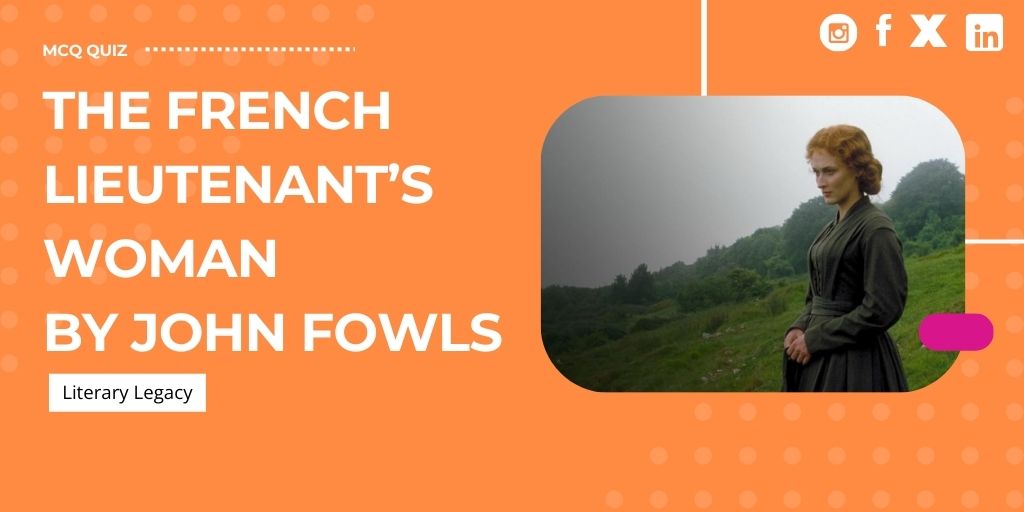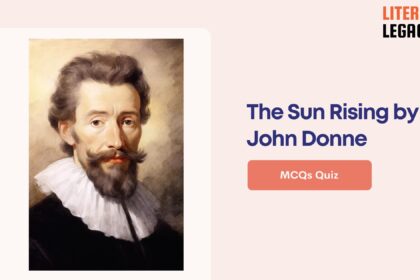1. What is Charles Smithson’s profession?
Choices
A) Draper
B) Amateur paleontologist
C) Ship captain
D) Professional geologist
Answer: (B)
Amateur paleontologist
Charles Smithson is introduced as an upper-class amateur paleontologist.
2. Why does Mrs. Poulteney hire Sarah Woodruff?
Choices
A) As a charity case
B) To be her friend
C) As a personal assistant
D) To manage her household
Answer: (A)
As a charity case
Mrs. Poulteney hires Sarah as a companion out of a sense of charity.
3. What is Sarah Woodruff waiting for?
Choices
A) Her family to reconcile with her
B) A opportunity to travel to France
C) A marriage proposal from Charles
D) A French lieutenant to return
Answer: (D)
A French lieutenant to return
Sarah is waiting for the return of the French lieutenant she fell in love with.
4. How does Charles feel about Sarah during their encounters?
Choices
A) He feels indifferent towards her.
B) He realizes he is attracted to her.
C) He sees her only as a charity case.
D) He is repulsed by her actions.
Answer: (B)
He realizes he is attracted to her.
Charles realizes his attraction to Sarah after their meetings.
5. What does Sarah reveal to Charles about the French lieutenant?
Choices
A) He is still injured from the shipwreck.
B) He has forgotten about her completely.
C) He has returned and wants to marry her.
D) He has married someone else.
Answer: (D)
He has married someone else.
Sarah tells Charles that the French lieutenant has married someone else.
6. What area is associated with immoral activities in the story?
Choices
A) The shoreline
B) The Undercliff
C) Charles’s home
D) Mrs. Poulteney’s house
Answer: (B)
The Undercliff
The Undercliff is depicted as an area associated with immoral activities.
7. Why does Sarah choose to walk in the Undercliff despite Mrs. Poulteney’s forbiddance?
Choices
A) She feels free there.
B) She is searching for fossils.
C) She wants to avoid other people.
D) She enjoys the wilderness.
Answer: (A)
She feels free there.
Sarah continues to walk in the Undercliff because she feels free there.
8. What does Charles initially insist regarding his meetings with Sarah?
Choices
A) They should go on an adventure together.
B) They should stop meeting.
C) He wants to help her immediately.
D) They should meet more often.
Answer: (B)
They should stop meeting.
Charles insists they should stop meeting because it is not proper.
9. Who falls in love with Mrs. Tranter’s maid, Mary?
Choices
A) Ernestina
B) Charles
C) Sam, the manservant
D) Dr. Grogan
Answer: (C)
Sam, the manservant
Sam, Charles’s manservant, is falling in love with Mary, Mrs. Tranter’s maid.
10. What does Sarah say she will do if she can’t talk to someone?
Choices
A) Become a nun.
B) Go mad.
C) Leave Lyme Regis.
D) Write a letter to the lieutenant.
Answer: (B)
Go mad.
Sarah expresses that she feels she will go mad if she can’t talk to someone sympathetic.
11. What condition does Dr. Grogan believe Sarah suffers from?
Choices
A) Anxiety
B) Melancholia
C) Obsessive Compulsive Disorder
D) Depression
Answer: (B)
Melancholia
Dr. Grogan diagnoses Sarah with melancholia, indicating her emotional distress.
12. What reason does Sarah give for wanting to be an outcast?
Choices
A) To find true love
B) To escape her family
C) To pursue a career
D) To have her suffering recognized
Answer: (D)
To have her suffering recognized
Sarah longs to be an outcast so that people will acknowledge the suffering she feels in her life.
13. What significant news does Sir Robert share with Charles during their meeting?
Choices
A) He is getting married
B) He has decided to adopt Charles
C) He is disowning Charles
D) He plans to grant Charles Winsyatt
Answer: (A)
He is getting married
Sir Robert reveals that he is getting married, which changes Charles’s prospects of inheriting the estate.
14. What does Dr. Grogan suspect about Sarah’s departure from employment?
Choices
A) She wanted to create a scene
B) She was forced to leave due to incompetence
C) She is manipulating everyone around her
D) She is pursuing a romantic relationship
Answer: (C)
She is manipulating everyone around her
Dr. Grogan thinks Sarah’s actions are part of her manipulation tactics, showing her desperation.
15. What does Charles discover about Sarah after their encounter in Exeter?
Choices
A) She is married
B) She has been lying about her past with Varguennes
C) She has a child
D) She is leaving the country
Answer: (B)
She has been lying about her past with Varguennes
Charles realizes that Sarah was a virgin and had been dishonest about her past with Varguennes.
16. What does Charles decide is necessary for the purpose of Christianity?
Choices
A) To create a world without suffering
B) To create a world where Christ can be uncrucified
C) To return to his first love
D) To repent for his sins
Answer: (B)
To create a world where Christ can be uncrucified
Charles comes to believe that Christianity should lead to a world where Christ is no longer condemned.
17. What does Charles send to Sarah with Sam after their time in Exeter?
Choices
A) A message inviting her to a ball
B) A letter breaking off his engagement to Ernestina
C) A note asking her to leave town
D) A ring
Answer: (B)
A letter breaking off his engagement to Ernestina
Charles sends a letter to Sarah through Sam, declaring his wish to break off his engagement to Ernestina.
18. What is Dr. Grogan’s reaction to Charles’s choice regarding his engagement?
Choices
A) He advises Charles to keep both women in his life
B) He believes Charles is morally despicable
C) He supports Charles’s decision
D) He suggests Charles should forget about love
Answer: (B)
He believes Charles is morally despicable
Dr. Grogan tells Charles that his actions are morally unacceptable, indicating the weight of his choice.
19. What does Sam express interest in during the course of the story?
Choices
A) Starting a business
B) Traveling abroad
C) Becoming Charles’s assistant
D) Engaging in a political career
Answer: (A)
Starting a business
Sam shows a desire to start a shop, indicating his ambitions for a better future.
20. What does Charles realize after he discovers blood on his shirt?
Choices
A) Sarah has been deceived by Varguennes
B) Sarah is not who she claims to be
C) Sarah was not a virgin
D) Sarah has harmed herself
Answer: (C)
Sarah was not a virgin
The blood on Charles’s shirt leads to the shocking realization that Sarah had lied about her past.
21. What motivates Charles to travel extensively after his confession of guilt?
Choices
A) His wish to escape Victorian society.
B) His depression and inability to find joy.
C) His desire to find Sarah.
D) His newfound success in business.
Answer: (B)
His depression and inability to find joy.
Charles’ depression after being forced to sign a confession leads him to travel for a year and a half without finding joy.
22. How does Sarah initially respond to Charles’ attempt to save her?
Choices
A) She rejects his help and refuses to be saved.
B) She expresses gratitude and love.
C) She agrees to run away with him.
D) She feigns indifference to provoke him.
Answer: (A)
She rejects his help and refuses to be saved.
Sarah does not want Charles to save her and assertively states they cannot be together.
23. What significant revelation does Sarah share with Charles during their argument?
Choices
A) She has his child.
B) She has developed feelings for another man.
C) She has plans to move to France.
D) She is married to someone else.
Answer: (A)
She has his child.
Sarah reveals to Charles that she has had his child, which introduces a possibility of hope for their family.
24. Which literary figure does Fowles reference as influencing his writing in ‘The French Lieutenant’s Woman’?
Choices
A) Leo Tolstoy.
B) Virginia Woolf.
C) Thomas Hardy.
D) Charles Dickens.
Answer: (C)
Thomas Hardy.
Fowles writes in the shadow of Thomas Hardy, who also dealt with themes of gender and sexuality.
25. What genre does ‘The French Lieutenant’s Woman’ belong to?
Choices
A) Historiographic metafiction.
B) Romantic fiction.
C) Historical fiction.
D) Science fiction.
Answer: (A)
Historiographic metafiction.
The novel is categorized as historiographic metafiction, blending history and fiction.
26. What societal issues does ‘The French Lieutenant’s Woman’ notably address?
Choices
A) Gender and sexuality.
B) Colonialism and imperialism.
C) Political corruption and injustice.
D) Economic disparity.
Answer: (A)
Gender and sexuality.
The novel explores various social issues, particularly focusing on gender and sexuality.
27. Which character in the story represents an antagonist to Charles and Sarah’s relationship?
Choices
A) Sam.
B) Mary.
C) Mrs. Poulteney.
D) Dante Gabriel Rossetti.
Answer: (C)
Mrs. Poulteney.
Mrs. Poulteney is one of the antagonists, representing the constraints of Victorian society.
28. What is the climax of ‘The French Lieutenant’s Woman’?
Choices
A) Charles receiving the telegram about Sarah.
B) Charles and Sarah’s argument.
C) Charles and Sarah having sex in Endicott’s Family Hotel.
D) Charles’ travel to the United States.
Answer: (C)
Charles and Sarah having sex in Endicott’s Family Hotel.
The climactic moment in the narrative is when Charles and Sarah become intimate in Endicott’s Family Hotel.
29. What aspect does the narrator of the novel consciously portray about himself?
Choices
A) He is pretentious and judgmental.
B) He is the sole creator of the characters’ fates.
C) He possesses omniscient knowledge about all characters.
D) He is a detached observer of the events.
Answer: (A)
He is pretentious and judgmental.
The narrator is portrayed as pretentious and judgmental, adding a layer of self-satire to the narrative.
30. What realization does Charles come to regarding life at the end of the narrative?
Choices
A) Life is meant to be enjoyed at every moment.
B) Life should be endured rather than solved.
C) Life is a series of challenges to be overcome.
D) Life is to be solved through logic.
Answer: (B)
Life should be endured rather than solved.
Charles ultimately realizes that life is to be endured rather than strictly solved, showcasing his character development.
31. What motivates Mrs. Poulteney’s actions towards Sarah?
Choices
A) She wants to assist Sarah in finding love.
B) She believes her charity will redeem her soul.
C) She is genuinely fond of Sarah and wishes to help her.
D) She wants to maintain her reputation in society.
Answer: (B)
She believes her charity will redeem her soul.
Mrs. Poulteney hopes her charity towards Sarah will save her own soul.
32. Why is Sarah Woodruff considered an outcast?
Choices
A) She is rumored to have behaved immorally.
B) She rejected the French lieutenant’s marriage proposal.
C) She was involved in a scandal with Mrs. Poulteney.
D) She did not meet the expectations of wealthy society.
Answer: (A)
She is rumored to have behaved immorally.
Sarah has been shunned because she is associated with immoral activities.
33. What does Charles Smithson feel compelled to do after meeting Sarah in the Undercliff?
Choices
A) Continue meeting Sarah despite the propriety.
B) Report Sarah to Mrs. Poulteney.
C) Confess his feelings for Sarah to Ernestina.
D) Stop meeting with Sarah for proper reasons.
Answer: (D)
Stop meeting with Sarah for proper reasons.
Charles initially insists they should stop meeting because it is not proper.
34. What event leads to Sarah’s despair regarding the French lieutenant?
Choices
A) She learns he is dead.
B) He writes her a letter ending their relationship.
C) He returns to Lyme Regis but ignores her.
D) She finds out he married another woman.
Answer: (D)
She finds out he married another woman.
Sarah reveals to Charles that the French lieutenant has married someone else.
35. What is Charles’s initial reaction to his attraction to Sarah?
Choices
A) He openly admits his feelings to Ernestina.
B) He suppresses his feelings and avoids her.
C) He decides to pursue a relationship with her.
D) He asks for advice from Dr. Grogan.
Answer: (B)
He suppresses his feelings and avoids her.
Charles realizes he is attracted to Sarah but does not tell Ernestina.
36. What location serves as a critical setting for Charles and Sarah’s secret meetings?
Choices
A) The Undercliff.
B) A secluded beach.
C) An abandoned cottage.
D) Mrs. Poulteney’s house.
Answer: (A)
The Undercliff.
Charles frequently visits the Undercliff to meet with Sarah.
37. How does Sarah first feel about sharing her story with Charles?
Choices
A) She is proud to tell it.
B) She is hesitant and fearful.
C) She believes it will harm her reputation.
D) She feels a sense of relief.
Answer: (D)
She feels a sense of relief.
Sarah feels like she will go mad if she can’t talk to someone sympathetic.
38. What social themes are reflected in the interactions between Charles and Sarah?
Choices
A) Wealth disparity and class conflict.
B) Romantic love and betrayal.
C) Religious beliefs and moral dilemmas.
D) Gender roles and societal expectations.
Answer: (D)
Gender roles and societal expectations.
Their interactions highlight gender roles and societal expectations of the time.
39. What significant decision does Charles make regarding his interactions with Sarah?
Choices
A) He plans to confront the French lieutenant directly.
B) He chooses to defend her against Mrs. Poulteney.
C) He decides to keep meeting her despite societal norms.
D) He resolves to leave Lyme Regis permanently.
Answer: (C)
He decides to keep meeting her despite societal norms.
Despite knowing it is improper, Charles agrees to meet Sarah again.
40. What underlying fear drives Mrs. Poulteney’s behavior towards Sarah?
Choices
A) Fear of losing her wealth.
B) Fear of social judgment.
C) Fear of abandonment by her friends.
D) Fear of moral condemnation.
Answer: (D)
Fear of moral condemnation.
Mrs. Poulteney hopes that her charity towards Sarah will save her own soul from hell.



